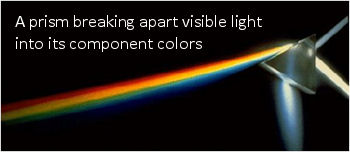How are Halos, Sundogs and Sun Pillars Created?
The atmosphere does more than just produce our daily weather: from sunny to cloudy days, dry to wet, stormy to snowy. The atmosphere is also capable of producing colorful displays when conditions are right. Some of these optical effects include halos, sun pillars, and sundogs. To better understand how the atmosphere produces these bursts of color, we need to understand a little something about light.
Light is electromagnetic radiation with a wavelength that is visible to the eye. This is the light we see. Visible light is composed of all the colors of the rainbow.

We can see these colors by using a prism. The properties of a prism allow it to break visible light apart into its component colors; colors ranging from the darkest reds, to the deepest violets, and everything in between.

In the atmosphere, under certain conditions, water drops and ice crystals can act as a prism, allowing us to see the various colors that make up visible light. Its because of these properties that we get the various atmospheric optical effects.
To add some understanding as to how the various atmospheric optical effects manifest themselves, it helps to understand the difference between refracted light and reflected light.
| Refraction | Reflection |
|
Refraction is the change in direction of a wave (in this case light) due to a change in its speed. This is most commonly observed when a wave passes from one medium to another at any angle other than 90° or 0°. So, when light is refracted inside a an ice crystal or water droplet in the air, its broken into its component colors. This creates the rainbow effect. |
Reflection of light occurs when the waves encounter a surface or other boundary that does not absorb the energy of the radiation and bounces the waves away from the surface. The light is not separated into its component colors because it is not being "bent" (or refracted), and all wavelengths are being reflected at equal angles.
|